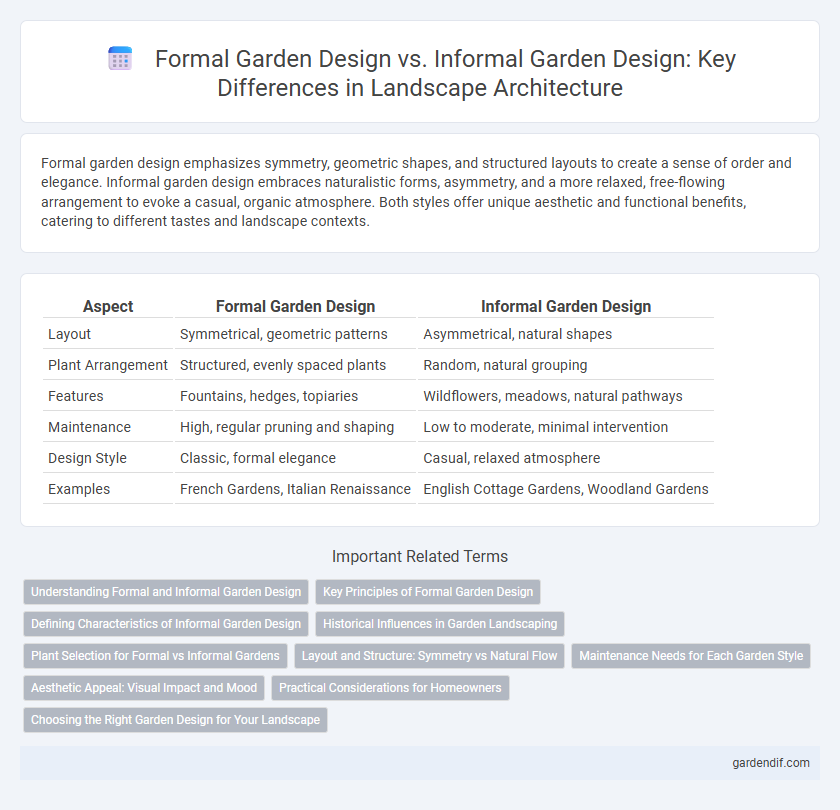
Formal Garden Design vs Informal Garden Design Illustration
Formal garden design emphasizes symmetry, geometric shapes, and structured layouts to create a sense of order and elegance. Informal garden design embraces naturalistic forms, asymmetry, and a more relaxed, free-flowing arrangement to evoke a casual, organic atmosphere. Both styles offer unique aesthetic and functional benefits, catering to different tastes and landscape contexts.
Table of Comparison
| Aspect | Formal Garden Design | Informal Garden Design |
|---|---|---|
| Layout | Symmetrical, geometric patterns | Asymmetrical, natural shapes |
| Plant Arrangement | Structured, evenly spaced plants | Random, natural grouping |
| Features | Fountains, hedges, topiaries | Wildflowers, meadows, natural pathways |
| Maintenance | High, regular pruning and shaping | Low to moderate, minimal intervention |
| Design Style | Classic, formal elegance | Casual, relaxed atmosphere |
| Examples | French Gardens, Italian Renaissance | English Cottage Gardens, Woodland Gardens |
Understanding Formal and Informal Garden Design
Formal garden design emphasizes symmetry, geometric shapes, and precise, well-maintained plant arrangements to create a structured and orderly aesthetic. Informal garden design prioritizes natural, flowing lines with asymmetrical layouts that mimic natural landscapes, promoting a relaxed and organic feel. Understanding the distinct characteristics of formal and informal garden designs helps landscape architects tailor spaces to suit aesthetic preferences and functional needs.
Key Principles of Formal Garden Design
Formal garden design emphasizes symmetry, geometric shapes, and structured layouts to create a sense of order and balance. Key principles include axial alignment, repetitive patterns, and neatly trimmed hedges or topiaries that define clear boundaries and focal points. This style often incorporates elements like gravel paths, parterres, and classical sculptures to enhance its controlled and harmonious appearance.
Defining Characteristics of Informal Garden Design
Informal garden design emphasizes natural shapes, asymmetry, and a relaxed, organic flow that mimics natural landscapes. Key characteristics include winding paths, irregular planting patterns, and diverse plant species arranged to create a spontaneous, unstructured appearance. This style promotes a harmonious blend with the surrounding environment, enhancing biodiversity and visual interest without rigid formality.
Historical Influences in Garden Landscaping
Formal garden design, rooted in Renaissance and French Baroque traditions, emphasizes symmetry, geometric shapes, and orderly patterns reflecting control over nature. Informal garden design draws inspiration from English Landscape gardens of the 18th century, prioritizing naturalistic layouts, asymmetry, and organic plant groupings to mimic natural scenery. These historical influences have shaped contemporary landscape architecture by balancing structured aesthetics with naturalistic elements.
Plant Selection for Formal vs Informal Gardens
Formal garden design emphasizes symmetrical plant selection, favoring neatly trimmed evergreens, boxwood hedges, and topiaries to maintain structured lines and geometric shapes. Informal garden design embraces diverse plant species with varying textures, colors, and heights, including native perennials, wildflowers, and shrubs, promoting a natural, relaxed appearance. Careful consideration of growth habits and seasonal interest ensures plant choices enhance the intended garden style and overall landscape harmony.
Layout and Structure: Symmetry vs Natural Flow
Formal garden design emphasizes symmetry, featuring geometric shapes, straight pathways, and evenly spaced plants to create a balanced and orderly layout. Informal garden design prioritizes natural flow with irregular shapes, curved lines, and varied plant groupings that mimic nature's spontaneity. The contrast between these styles lies in formal gardens' structured, precise arrangement versus informal gardens' organic, free-form structure.
Maintenance Needs for Each Garden Style
Formal garden design requires regular maintenance including precise pruning, frequent weeding, and careful shaping of hedges to maintain its symmetrical patterns and geometric layout. Informal garden design demands less intensive upkeep, focusing on seasonal pruning, natural mulching, and minimal intervention to preserve its relaxed, organic appearance. Understanding these contrasting maintenance needs helps in selecting a garden style aligned with available time and gardening skill.
Aesthetic Appeal: Visual Impact and Mood
Formal garden design emphasizes symmetry, structured patterns, and geometric shapes, creating a sense of order and elegance that enhances visual impact and conveys a refined mood. Informal garden design uses naturalistic layouts with asymmetrical arrangements, fostering a relaxed, organic atmosphere that evokes tranquility and spontaneity. Both styles strategically manipulate visual elements like paths, plant groupings, and focal points to influence the viewer's emotional response and overall garden experience.
Practical Considerations for Homeowners
Formal garden design emphasizes symmetry, geometric shapes, and structured layouts, making maintenance predictable but potentially labor-intensive with regular pruning and edging. Informal garden design offers a more naturalistic approach with free-form planting and organic shapes, which can be easier to maintain but may require more attention to weed control and plant selection. Homeowners should consider their available time, gardening skills, and aesthetic preferences to choose the best garden style that aligns with their lifestyle and property conditions.
Choosing the Right Garden Design for Your Landscape
Formal garden design emphasizes symmetry, geometric shapes, and structured layouts, creating a visually balanced and orderly landscape. Informal garden design embraces natural curves, asymmetry, and free-form plant arrangements, fostering a relaxed and organic atmosphere. Choosing the right garden design depends on the existing landscape features, homeowner preferences, and the desired aesthetic impact to achieve harmony and function in outdoor spaces.
Formal Garden Design vs Informal Garden Design Infographic

 gardendif.com
gardendif.com